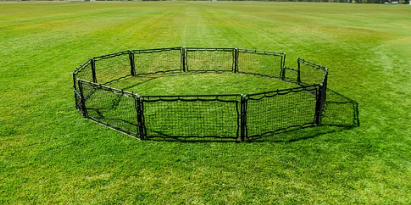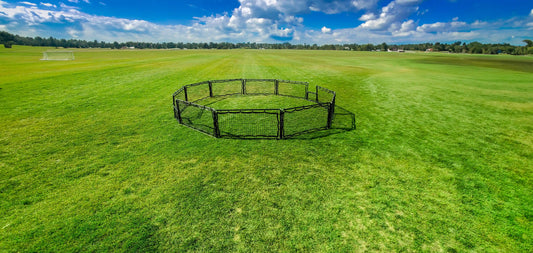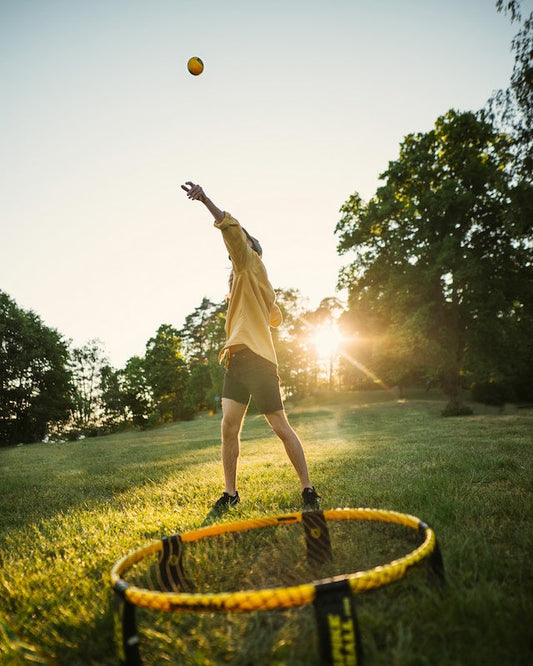Looking for some high-flying excitement to inject into your next group activity? Look no further than the versatile and endlessly entertaining world of frisbee games! Whether you're a seasoned educator or a youth leader planning a large gathering or looking for a good idea for you next outing, these frisbee-inspired activities are sure to keep everyone on their toes and spirits soaring.
With the iconic flying disc at the center of the action, these games combine athleticism, teamwork, and a whole lot of fun. From classic favorites to innovative twists, there's something here to engage players of all ages and skill levels.
We'll explore a variety of frisbee game ideas that are perfect for PE teachers, youth leaders, or anyone looking to add an extra dash of excitement to their events. Whether you're aiming to improve throwing accuracy, foster team collaboration, or simply get everyone moving and laughing together, these games have you covered.
So, grab your flying disc, gather your group, and get ready to unleash the energy and excitement of disc sports. Let's dive into the world of frisbee games and discover new ways to elevate your next gathering or class activity!
Kan Jam
Kan Jam, the latest in frisbee games, is an outdoor backyard game that combines elements of frisbee and teamwork. It's a simple yet highly engaging game that can be enjoyed by people of all ages. The objective of Kan Jam is to score points by successfully throwing a frisbee through a slot in a large can-shaped goal.
Game Setup:
- Equipment: Kan Jam requires the following equipment:
- Two durable, lightweight plastic cans with open tops and slotted sides.
- One frisbee.
- Team Formation: The game is typically played with two teams of two players each.
- Game Layout: Teams position themselves at opposite ends of the playing area, similar to cornhole, with the Kan Jam goals placed in the center.
Game Rules:
- Goal Structure: The Kan Jam goals consist of two cans placed approximately 50 feet apart. The cans have open tops and a slot on the front, facing the opposing team.
- Scoring: The primary objective is to score points by throwing the frisbee through the slot in the front of the Kan Jam can. There are a few ways to score:
- A "Dinger" or is a hit any part of the can by the frisbee after being deflected from your teammates hand to the can. This awards 1 pt.
- A “Deuce” or the thrower hits the side of the goal with out any assistance from your teammate or deflector. This awards 2 pts.
- A “Dunk” or when the frisbee is deflected by the deflector and its lands inside of the can by any means. This awards 3 pts.
- A “Done Deal” or if the thrower was to land the disc inside of the can by entrance through the slot in the front of the can without any deflection or assistance. This awards 21 pts, or an automatic win.
- A “Interference” or considered a penalty point when the opposing team in anyway interferes with the frisbee after it is thrown. This awards 3 pts for the team that was throwing.
- Gameplay: The team not throwing the frisbee is to wait there turn and let the other team play out their toss. Trying to prevent the frisbee from entering the can as the opposing team will award an “interreference” point to the other team. Your teammates will have a thrower, which throws behind the opposite can and the other uses their hands to deflect the frisbee and score points as previously explained.
- Throwing Turns: Each team takes turns throwing the frisbee. The player throwing must stand behind their team's goal.
- Scoring System: A set number of points should be determined before play begins to set a goal to reach, often 21 will be the standardized score.
- Winning the Game: The first team to reach the set number of points or achieve a "Done Deal" is declared the winner.
Kan Jam is loved for its simplicity, making it easy for players of all skill levels to enjoy. It combines elements of strategy, accuracy, and teamwork, creating an exciting and social outdoor experience. The game's popularity has led to organized leagues and tournaments, adding a competitive edge to this backyard favorite.
Ultimate Frisbee

Ultimate frisbee, often simply referred to as "ultimate," is a fast-paced team sport played with a flying disc (frisbee). It combines elements of soccer, basketball, and football, emphasizing sportsmanship and fair play. Ultimate frisbee is played in various settings, from casual pickup games to organized leagues and tournaments.
Key Features of Ultimate Frisbee:
- Teams: Two teams compete against each other, with each team typically consisting of seven players.
- Field: The game is played on a rectangular field with end zones at each end. The dimensions of the field can vary, but a standard field is 70 yards long and 40 yards wide, with end zones that are 25 yards deep.
- Starting Play: The game begins with a "pull," which is a throw-off similar to a kickoff in football. The defensive team throws the frisbee to the offensive team, initiating play.
- Movement: Players move the frisbee by passing it among teammates. The player with the frisbee cannot run but may pivot on one foot. The defender guarding the player with the frisbee is called the marker.
- Scoring: Points are scored when a player catches the frisbee in the opposing team's end zone. Each goal is worth one point.
- Turnovers: A turnover occurs if the frisbee is dropped, intercepted, goes out of bounds, or if a pass is incomplete. When a turnover happens, the opposing team gains possession.
- Non-Contact Sport: Ultimate is a non-contact sport, and physical contact between players is generally discouraged. Fouls may be called by players, and the game promotes a spirit of fair play and sportsmanship.
- Continuity of Play: The game is known for its continuous flow, with players quickly transitioning between offense and defense. Substitutions can occur during stoppages in play.
- Self-Officiating: Ultimate relies on a principle known as the "Spirit of the Game," where players are responsible for fair play and sportsmanship. The game is often played without referees, and players make their own calls, resolving disputes on the field.
- End of Point: A point is scored when the frisbee is caught in the opposing team's end zone. After a point is scored, teams switch roles, and the team that scored pulls the frisbee to the other team to restart play.
- Halftime and Time Cap: The game is typically played to a certain number of points, and there is a halftime break. In tournament play, there may be a time cap, and the team with the most points at that time is declared the winner.
Ultimate frisbee is not only a dynamic and exciting sport but also places a strong emphasis on fair play, sportsmanship, and the camaraderie of players. It has grown in popularity globally, with organized leagues, college and club teams, and international competitions showcasing the athleticism and spirit of the game.
Frisbee Tic Tac Toe
Playing Tic-Tac-Toe using a hill and the game 9 Square adds an interesting and dynamic element to the traditional game. Here's how you can set it up:
Setup:
- Hill: Find a hill with a gentle slope where players can stand at different heights.
- 9 Square Game: Set up the 9 Square in the middle or at the bottom of the hill. If you're not familiar with 9 Square, it's a game played in a 3x3 grid where players must hit the ball into one of the squares, and the ball can only be touched once per square.
Gameplay:
- Divide Players: Divide the players into two teams, and each team stands at different heights on the hill. The higher up you are on the hill, the more control you have over the trajectory of the ball.
- Play 9 Square: Begin playing 9 Square as you normally would, with players hitting the ball into the squares. The goal is to eliminate opponents and move up to the highest position on the hill.
- Tic-Tac-Toe Integration: When a team member is eliminated from the 9 Square game, they move to a designated area where they can place a marker (e.g., a cone or chalk) on a corresponding spot on a giant Tic-Tac-Toe grid drawn on the hillside.
- Winning Tic-Tac-Toe: The team's goal is not only to win in the 9 Square game but also to strategically place their markers on the Tic-Tac-Toe grid to get three in a row vertically, horizontally, or diagonally.
- Combining Strategies: Players need to balance their efforts between winning in 9 Square to gain advantageous positions on the hill and placing markers strategically on the Tic-Tac-Toe grid to secure victory.
Winning the Overall Game:
- The first team to achieve three in a row on the Tic-Tac-Toe grid, while also maintaining control of the hill by winning in 9 Square, wins the overall game.
This combined setup introduces a physical and strategic element to the classic Tic-Tac-Toe game, making it more dynamic and engaging. It encourages teamwork, coordination, and quick thinking as players strategize to dominate both the hill and the Tic-Tac-Toe grid.
Disc Golf

Disc golf, also known as frisbee golf, is a sport that shares similarities with traditional golf, but instead of using clubs and golf balls, players use flying discs or frisbees to complete a course. The objective is to complete the course in as few throws as possible, navigating through a series of target baskets.
Key Elements of Disc Golf:
- Course Layout: A disc golf course consists of a series of holes, often 9 or 18, with each hole having a designated starting point and a target basket. Courses can vary in terrain, offering a mix of open fields, wooded areas, and elevation changes.
- Tee Throws: Players start each hole with a tee throw, aiming to launch the disc toward the target basket. The starting point is known as the tee box.
- Fairway Throws: After the initial tee throw, players progress through the course by making fairway throws. The objective is to reach the target basket in as few throws as possible.
- Target Baskets: Target baskets consist of a metal basket suspended above the ground with hanging chains. The chains help catch and slow down the disc, allowing it to fall into the basket.
- Scoring: Scoring in disc golf is based on the number of throws it takes to complete a hole. The player with the fewest throws at the end of the course is the winner. Each throw is counted as a stroke.
- Par: Each hole has a designated par, representing the average number of throws it should take a skilled player to complete the hole. Players aim to complete the hole in fewer throws than the par.
- Obstacles: Courses often include natural obstacles such as trees, bushes, and water hazards, adding an element of challenge and strategy to the game.
- Variations: Disc golf can be played in various formats, including singles (individual play) and doubles (team play). Some courses also offer alternative tee positions for players of different skill levels.
- Disc Types: Different types of discs are used for various throws in disc golf. Drivers are designed for long-distance throws, mid-range discs for medium distances, and putters for short, accurate throws.
- Etiquette: Similar to traditional golf, disc golf has a code of etiquette that encourages fair play, respect for fellow players, and consideration for the course and environment.
Disc golf is known for its accessibility, as it can be played by people of all ages and skill levels. It combines physical activity with strategy and precision, making it a popular recreational sport in parks and dedicated courses around the world. The community aspect of disc golf is also notable, as players often share a sense of camaraderie and love for the game.
Monkey in the Middle

Monkey in the Middle, often played with a frisbee, is an active and engaging game that involves three or more players. The objective is for the players on the outside to pass the frisbee back and forth while the player in the middle attempts to intercept or "monkey" the frisbee. The game combines elements of teamwork, agility, and strategic passing.
How to Play Monkey in the Middle with a Frisbee:
Setup:
- Players: Ideally, you need at least three players to play Monkey in the Middle with a frisbee.
- Formation: Have the players stand in a circle, with one player designated as the "monkey" in the middle.
Gameplay:
- Passing: The players on the outside of the circle pass the frisbee among themselves, trying to keep it away from the player in the middle (the monkey).
- Monkey's Objective: The player in the middle attempts to intercept the frisbee by jumping, reaching, or using any other means to get their hands on it.
- Interception: If the monkey successfully intercepts the frisbee, the player who threw it becomes the new monkey. The game continues with the new monkey in the middle.
- Avoidance: Players on the outside aim to pass the frisbee quickly and accurately to prevent the monkey from making an interception. They can move around the circle to create passing angles and avoid the monkey.
Additional Tips:
- Speed and Agility: The game becomes more exciting when players move quickly and demonstrate agility in both passing and intercepting the frisbee.
- Teamwork: Players can strategize and work together to outmaneuver the monkey, creating opportunities for passing without getting intercepted.
- Varying Difficulty: To make the game more challenging, you can introduce variations such as requiring a certain number of passes before attempting to intercept or allowing the monkey to use only one hand.
Ending the Game:
- The game can continue for a set duration, or you can choose to end it when everyone has had a chance to be the monkey.
Monkey in the Middle with a frisbee is a lively and dynamic game that encourages quick thinking, teamwork, and physical activity. It's a great way to enjoy the outdoors, enhance hand-eye coordination, and have fun with friends or family.

Jackpot
Jackpot is a frisbee game that combines elements of accuracy and target throwing. It's a simple and enjoyable game suitable for players of various skill levels. The objective is to score points by landing the frisbee in designated scoring zones on the playing field.
How to Play Jackpot with a Frisbee:
Setup:
- Players: Jackpot can be played with two or more players.
- Scoring Zones: Designate scoring zones on the playing field. These can be marked with cones, chalk lines, or other indicators. You can have multiple scoring zones with varying point values.
Gameplay:
- Starting Throws: Players take turns throwing the frisbee towards the scoring zones from a designated starting point. The frisbee must be thrown from behind a specified throwing line.
- Scoring: Points are awarded based on where the frisbee lands:
- The closest scoring zone typically awards fewer points, while farther zones or more challenging targets yield higher points.
- Some variations may include bonus points for landing the frisbee in a specific zone or hitting a designated target.
- Jackpot Throws: Players can earn a "jackpot" throw by meeting certain conditions, such as landing the frisbee in the highest-scoring zone or hitting a bonus target.
- Rotation: After each round of throws, players rotate, and the next player takes their turn.
- Winning: The game can be played for a set number of rounds, and the player with the highest total score at the end is declared the winner.
Variations:
- Distance Challenge: Increase the challenge by introducing different distances for the scoring zones.
- Obstacle Course: Set up obstacles on the field, and players earn additional points for navigating the frisbee through or around them.
- Team Play: Divide players into teams, and each team takes turns throwing. The team with the highest cumulative score wins.
Additional Tips:
- Fair Play: Ensure fair play by having players respect throwing lines and wait for their turn.
- Creative Targets: Get creative with the scoring zones—use natural features or incorporate objects like trees or posts as additional targets.
Jackpot with a frisbee is a versatile, fun game that can be adapted to different settings and skill levels. It encourages precision throwing, strategic decision-making, and friendly competition, making it a fun addition to outdoor activities.
The frisbee isn't just a plastic disc—it's a catalyst for joy, connection, and endless fun. From impromptu backyard tosses to organized ultimate games, it brings people together like few other activities can. Its versatility shines in outdoor games, providing a backdrop for laughter and camaraderie. So, whether you're planning activities for kids or simply looking for a great game to play with friends and family, the frisbee is always a winning choice. It's not just about the game itself; it's about the shared moments, the memories made, and the bonds strengthened. So grab your disc, head outside, and let the excitement begin. After all, with the frisbee in hand, the fun never stops!







